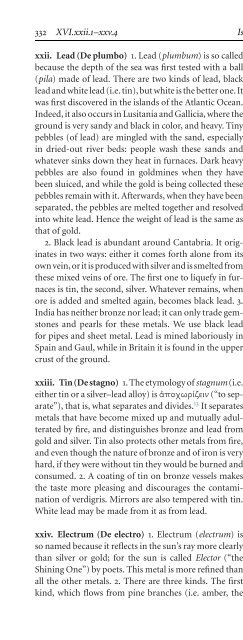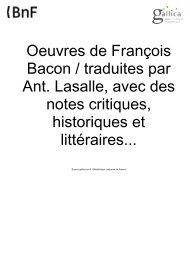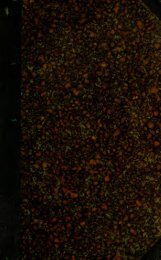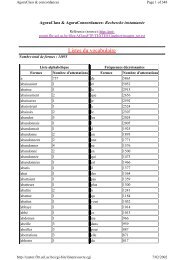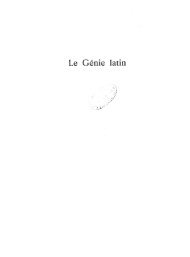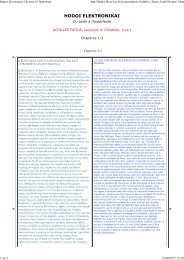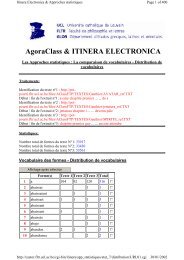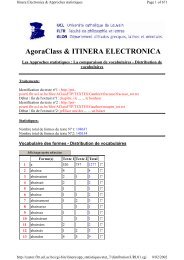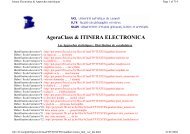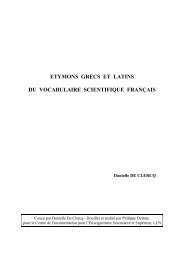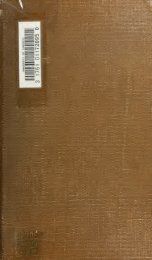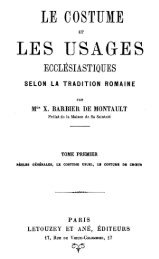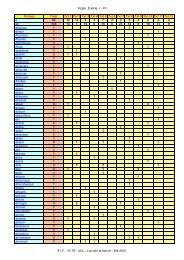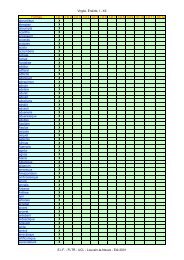The Etymologies of Isidore of Seville - Pot-pourri
The Etymologies of Isidore of Seville - Pot-pourri
The Etymologies of Isidore of Seville - Pot-pourri
Create successful ePaper yourself
Turn your PDF publications into a flip-book with our unique Google optimized e-Paper software.
332 XVI.xxii.1–xxv.4 <strong>Isidore</strong> <strong>of</strong> <strong>Seville</strong><br />
xxii. Lead (De plumbo) 1.Lead(plumbum)issocalled<br />
because the depth <strong>of</strong> the sea was first tested with a ball<br />
(pila) made<strong>of</strong>lead.<strong>The</strong>rearetwo kinds <strong>of</strong> lead, black<br />
lead and white lead (i.e. tin), but white is the better one. It<br />
was first discovered in the islands <strong>of</strong> the Atlantic Ocean.<br />
Indeed, it also occurs in Lusitania and Gallicia, where the<br />
ground is very sandy and black in color, and heavy. Tiny<br />
pebbles (<strong>of</strong> lead) are mingled with the sand, especially<br />
in dried-out river beds: people wash these sands and<br />
whatever sinks down they heat in furnaces. Dark heavy<br />
pebbles are also found in goldmines when they have<br />
been sluiced, and while the gold is being collected these<br />
pebbles remain with it. Afterwards, when they have been<br />
separated, the pebbles are melted together and resolved<br />
into white lead. Hence the weight <strong>of</strong> lead is the same as<br />
that <strong>of</strong> gold.<br />
2. Blackleadisabundant around Cantabria. It originates<br />
in two ways: either it comes forth alone from its<br />
own vein, or it is produced with silver and is smelted from<br />
these mixed veins <strong>of</strong> ore. <strong>The</strong> first one to liquefy in furnaces<br />
is tin, the second, silver. Whatever remains, when<br />
ore is added and smelted again, becomes black lead. 3.<br />
India has neither bronze nor lead; it can only trade gemstones<br />
and pearls for these metals. We use black lead<br />
for pipes and sheet metal. Lead is mined laboriously in<br />
Spain and Gaul, while in Britain it is found in the upper<br />
crust <strong>of</strong> the ground.<br />
xxiii. Tin (De stagno) 1.<strong>The</strong> etymology <strong>of</strong> stagnum (i.e.<br />
either tin or a silver–lead alloy) is (“to separate”),<br />
that is, what separates and divides. 13 It separates<br />
metals that have become mixed up and mutually adulterated<br />
by fire, and distinguishes bronze and lead from<br />
gold and silver. Tin also protects other metals from fire,<br />
and even though the nature <strong>of</strong> bronze and <strong>of</strong> iron is very<br />
hard, if they were without tin they would be burned and<br />
consumed. 2. Acoating <strong>of</strong> tin on bronze vessels makes<br />
the taste more pleasing and discourages the contamination<br />
<strong>of</strong> verdigris. Mirrors are also tempered with tin.<br />
White lead may be made from it as from lead.<br />
xxiv. Electrum (De electro) 1. Electrum(electrum) is<br />
so named because it reflects in the sun’s ray more clearly<br />
than silver or gold; for the sun is called Elector (“the<br />
Shining One”) by poets. This metal is more refined than<br />
all the other metals. 2. <strong>The</strong>reare three kinds. <strong>The</strong> first<br />
kind, which flows from pine branches (i.e. amber, the<br />
primary meaning <strong>of</strong> electrum), is called ‘liquid electrum.’<br />
<strong>The</strong> second, which is found naturally and held in esteem,<br />
is ‘metallic electrum.’ <strong>The</strong> third kind is made from three<br />
parts gold and one part silver. You will find these same<br />
proportions if you melt natural electrum, for there is no<br />
difference between natural electrum and manufactured;<br />
both have the same nature. 3. Electrum that is natural<br />
has a character such that at a banquet it gleams even<br />
more brightly by lamplight than all the other metals. It<br />
also reveals poison, for if you pour some poison into a<br />
vessel made from it, it makes a harsh noise and gives <strong>of</strong>f<br />
avariety <strong>of</strong> colors like a rainbow.<br />
xxv. Weights (De ponderibus) 1. Itishelpfultoknow<br />
about weights and measures, for all bodies, as has been<br />
written, are disposed and formed from the highest to the<br />
lowest with measure and number and weight (see Wisdom<br />
11:21). Nature gives weight to all corporeal objects,<br />
and “each object is ruled by its own weight” (Poem about<br />
Weights and Measures [anon.], 3). 2. FirstMoses, [who<br />
preceded all <strong>of</strong> the pagan philosophers chronologically,<br />
recorded for us numbers and measures and weights in<br />
diverse places in his writing]. <strong>The</strong> Argive Phidon first<br />
established the system <strong>of</strong> weights in Greece, and although<br />
there were others more ancient than he, he was more<br />
active in this art. 3.Aweight (pondus)issocalled because<br />
it hangs (pendere) balanced in the scales, hence also the<br />
term pensum (“something weighed”). 14 <strong>The</strong> term pondus<br />
is loosely used for one pound (libra). 15 Hence also<br />
the dipondius (i.e. dupondius)isnamed, as if it were duo<br />
pondera (“two pounds”); this term has been retained in<br />
usage up to today.<br />
4.Atrutina (i.e. a kind <strong>of</strong> scale) is an instrument that<br />
suspends two weighted plates from a balance-tongue.<br />
It is made for weighing talents and hundred-pound<br />
13 <strong>The</strong> etymology is that provided by Jerome for the Hebrew word<br />
for tin.<br />
14 <strong>The</strong> following are the relationships <strong>of</strong> the weights discussed<br />
here: 1 calcus = 2 lentils; 1 obol = 2 ceratin = 3 siliquae = 4 calci; 1<br />
scripulus = 6 siliquae; 1 drachma = 3 scripuli = 18 siliquae; 1 solidus<br />
(sextula) = 3 tremisses = 24 siliquae; 1 duella = 2 sextulae; 1 stater<br />
(semissis) = 3 sextulae = 3 aurei = 2 sicli = 4 drachmas; 1 ounce =<br />
2 stateres = 8 drachmas = 24 scripuli = 4 quadrantes; 1 pound =<br />
12 ounces; 1 mina = 25 stateres = 75 solidi = 100 drachmas = 225<br />
tremisses = 1,800 siliquae.<br />
15 <strong>The</strong> Roman libra is about three-fourths <strong>of</strong> the modern pound<br />
avoirdupois. <strong>The</strong> dupondius is literally the sum <strong>of</strong> two asses, coins<br />
originally <strong>of</strong> one Roman pound.


